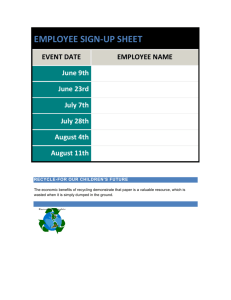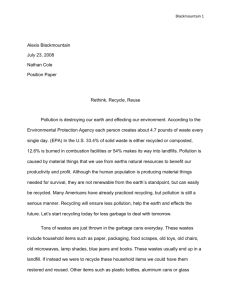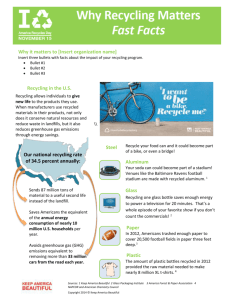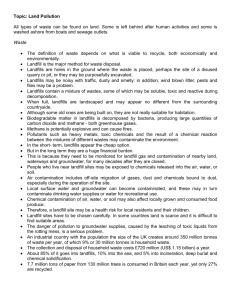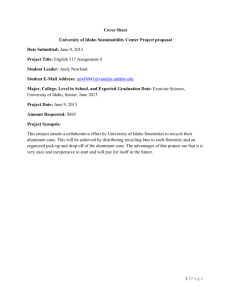Enhancing my locker MYP II B
advertisement
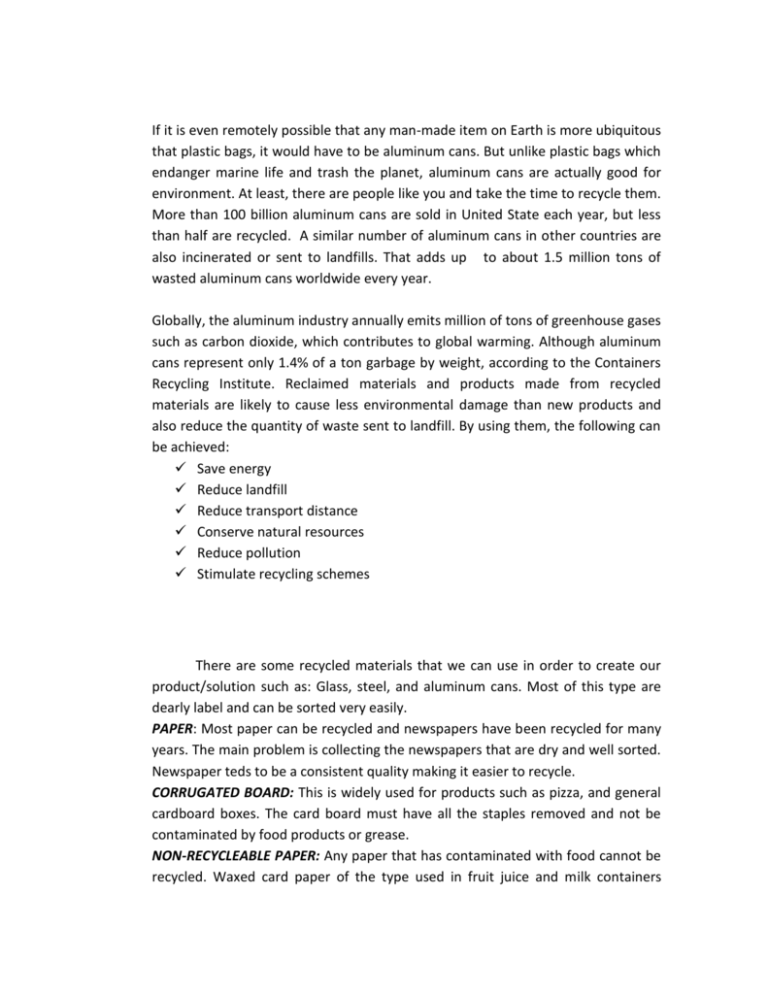
If it is even remotely possible that any man-made item on Earth is more ubiquitous that plastic bags, it would have to be aluminum cans. But unlike plastic bags which endanger marine life and trash the planet, aluminum cans are actually good for environment. At least, there are people like you and take the time to recycle them. More than 100 billion aluminum cans are sold in United State each year, but less than half are recycled. A similar number of aluminum cans in other countries are also incinerated or sent to landfills. That adds up to about 1.5 million tons of wasted aluminum cans worldwide every year. Globally, the aluminum industry annually emits million of tons of greenhouse gases such as carbon dioxide, which contributes to global warming. Although aluminum cans represent only 1.4% of a ton garbage by weight, according to the Containers Recycling Institute. Reclaimed materials and products made from recycled materials are likely to cause less environmental damage than new products and also reduce the quantity of waste sent to landfill. By using them, the following can be achieved: Save energy Reduce landfill Reduce transport distance Conserve natural resources Reduce pollution Stimulate recycling schemes There are some recycled materials that we can use in order to create our product/solution such as: Glass, steel, and aluminum cans. Most of this type are dearly label and can be sorted very easily. PAPER: Most paper can be recycled and newspapers have been recycled for many years. The main problem is collecting the newspapers that are dry and well sorted. Newspaper teds to be a consistent quality making it easier to recycle. CORRUGATED BOARD: This is widely used for products such as pizza, and general cardboard boxes. The card board must have all the staples removed and not be contaminated by food products or grease. NON-RECYCLEABLE PAPER: Any paper that has contaminated with food cannot be recycled. Waxed card paper of the type used in fruit juice and milk containers cannot be recycled. Furthermore, plastic laminated card can cause problems during the recycling process and this should not be recycled. FRIDGES/FREEZERS Older fridges and freezes relied on a gas called Chlorinated Fluorocarbon more commonly known as “CFC” .These gases have been blamed for serious damage to the Earth’s ozone layer. Consequently they must be removed before recycling of a fridge or freezer can take place .The symbol appositive is found on appliances than contain CFC gases. BATTERIES: are more difficult to recycle. Single use batteries often referred to as Alkaline Batteries should not be placed in a dust bin and should be collected. However, these usually end up in a separate landfill. Rechargeable batteries often contain toxic materials that are quite stable when the batteries are in use. WOOD: can be salvaged from several sources for use in new products. Wood pallets which are used in manufacturing and warehousing to stack products for easy movements via forklift. Wood salvaged from residential and commercial constructions and demolition can also be uses in new products. End tables, coffee tables, dresses and other type of furniture can all be made from reclaimed and recycled wood. Online and of line retainers special PLASTICS: are chemically separated by numbers. The most common are #1 (PETE) used in soda and water bottles, and number 2 (HDPE) used in detergent and milk bottles. Every container is made with different chemicals that get together for a specific shape or color, with different temperatures so, they can’t be melted and recycled together. PET bottle get transform into many thing that we use daily, and we don’t even know it. After having a transformation, recycled bottles can be used for building or even a bridge. They can be used also for clothing. They mix the bottles with some other fibers and make the clothing. There is a material called “ECOFLEECE” that is used in many cloths, and shoes; and is totally earth.-friendly which is a great way to reuse things and cover the needs. Bibliography Retrieved date from www.technologystudents.com/pcaddes1/recyc3.html Retrieved date from www.ecofriendkids.com.uk/aguidewhatproductscanberecycled.html Retrieved date from www.admin.com.ac.uk/office/em/sustainbility/environment/guidance/construction.html Retrieved date from www.wenvironment.about.com/ed/recycling/o(the-benefitsofaluminum-recycling-why-recycle-aluminum.html Retrieved October 6th,2012 from http://discovermagazine.com/2009/jul-agus/06-whenrecycling-is-bad-for-the-environment Retrieved October 6th,2012 from http://earthall.com/news/2010/03/22/what-not-to-putin-the-bin Retrieved October 6th,2012 from http://www.enow.com/about_5380025_productsplastic-soda-juice-bottles.html Retrieved October 6th,2012 from http://eart911.com/news/2012/08/16/8-things-madeof-recycled-plastic-bottles.html


